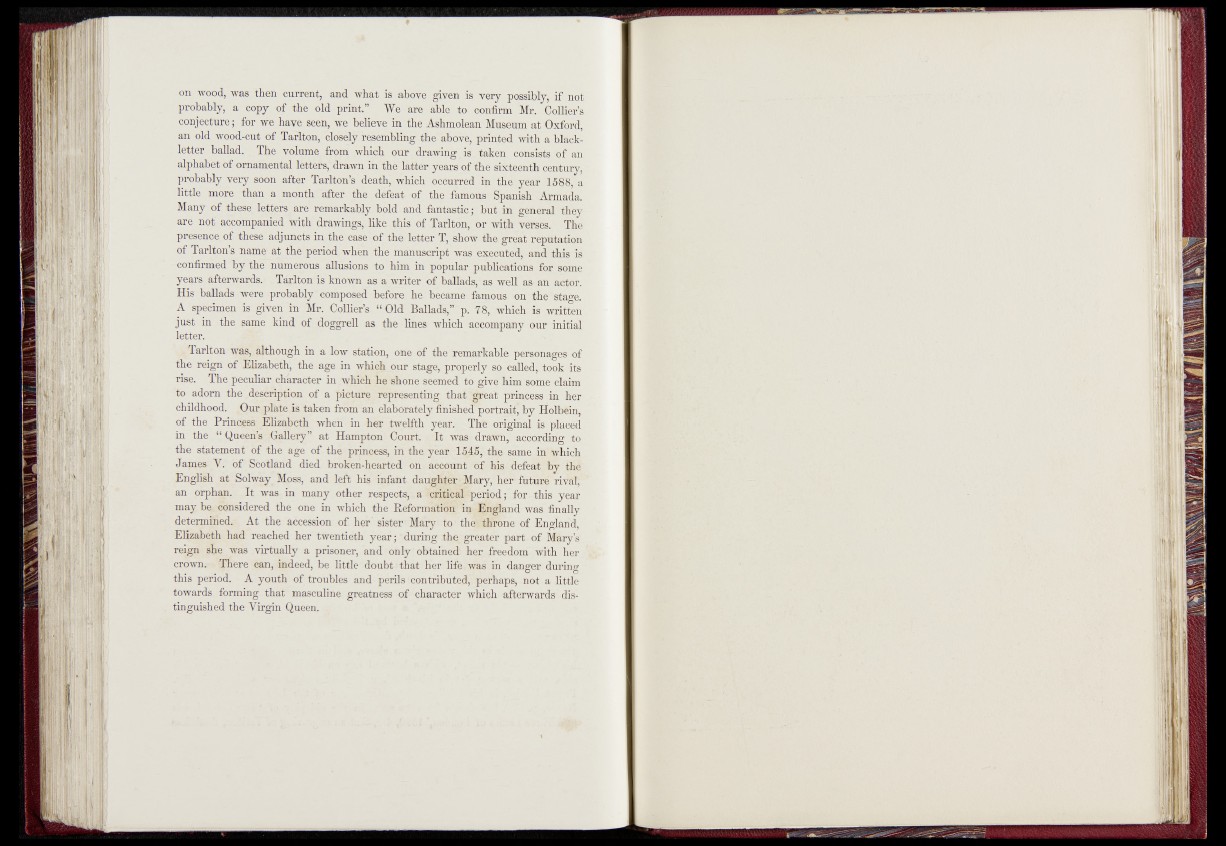
on wood, was .'then current, and what is above given is very possibly, if not
probably, a copy of the old-print.” We are able^to confirm Mr.-Q'.oili^s
conjecture; for we have, seen, -we believe in the Ashmolean' Museum at Oxford,
an old w'dod-cut of Tarlton,'closely resembling the- above,printed with a black-
letter ballad. ..The volume.fr pm which our drawing f is, taken consists‘of an
alphabet of ornamental litters* drawn injfche latter years of the'sixteenth century,
probably, very soon after Tarlton’s death, which occurred-in the year 15b8,"a
little more than a month after the^defeat of ^ f am o u s Spanish'vArmada.
Many . o |* 0 ^ let^rs,are remarkably bold and fantastic; but in geheraTthey-
Are not" accompanied, with drawings, like this of Tarltbn, or with verses. J f e
presence of these adjuncts in. the case‘of theletter T, show the great reputation
of Tarlton’s name at. the period when the manuscript was executed,’ and this is
-confirmed’by the numerous allusions to him in popular publications for some
ye$ra afterwards. Tarlton is known as a writer of ball'adspas,#eli^as-an actor.
His ballads were probably'composed before he became famous on tEe^stage.
A specimen is .given in Mr. Collier’s “ Old'Ballads,” p. 78£which is written
just in the sar^e kind of doggrell as the lines which accompany bu^” initial
letter.
^Tarlton was, .although in a low station, ohe of the remarkabierpt^^ha^es of
3®gn of Elizabeth, the age in which our stage, properly aso called,* tdok its
rfee. The pecidiar.diaracter in which he shone sCemed foigive him some claim
to adorn the .description of a picture representing that *^reat princess
childhood* ,Qur^ l||ejs taken from an elaborately nnishea^orteg^^r HolWftn,
of the Prin^ss /Elizabeth whcfivin her twelfth year. Ttff original is place d
in .thej“ Queen’s. itSalle^” at Hampton Court. It was drawn, according to
the statement of the age of the princess, in the year 1-^fo, the sine u£$jhioh
James _V. of; Scotland died, broken-hearted on aecount o f h ^ ^ e f e ^ b y
English at; Solway Moss, and left his infant daughter*Maay,'hei*futur^’ rivSlf"
an orphan. It was, in many other respects, * a "'critical w>eriod ■' for-tins-.year
may h^@$flsidered the one in which the Reformation in England was liiuillvr j
d e t^ a j^ e ^ : At the accession of her " sister' Mary to/ th ^ fro n e ipf.EngTanS,
Elizabeth had reached her twentieth year; ‘during.th^ greater part-of Mary’s;
r ^ A e was virtually a prisoner, and only obtained; her^-freedom with HerJ
crowii. There can, indeed, be little “doubt i that her life was in danger during ■
this period. A youth of troubles and perils 'contributed,perhaps, not a littlfe-
towards, forming that masculine greatness of character which afterwards distinguished
the-Virgin Queen. .